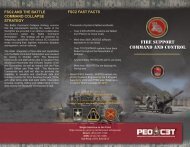2012 Annual Report to the Stakeholders - PEO C3T - U.S. Army
2012 Annual Report to the Stakeholders - PEO C3T - U.S. Army
2012 Annual Report to the Stakeholders - PEO C3T - U.S. Army
Create successful ePaper yourself
Turn your PDF publications into a flip-book with our unique Google optimized e-Paper software.
<strong>2012</strong> annual report <strong>to</strong> <strong>the</strong> stakeholders<br />
fA<strong>the</strong>R of u.S. ARmy<br />
RAdAR building dedicAtion<br />
240 MeGa cycle radio detec<strong>to</strong>r<br />
this Detec<strong>to</strong>r was built in 1937 <strong>to</strong> utilize<br />
<strong>the</strong> more comPact antenna structures<br />
suitable at higher frequencies. both<br />
transmitter anD receiver were mounteD<br />
on a single sounD loca<strong>to</strong>r chassis. <strong>the</strong><br />
equiPment was testeD against both aircraft<br />
anD meteorological balloons.<br />
radio pUlse proJec<strong>to</strong>r<br />
this Directional array, comPrising ten<br />
horizontal DiPoles with an equal number<br />
of reflec<strong>to</strong>rs, was useD with <strong>the</strong> 1937<br />
Demonstration Pulse transmitter.<br />
DeDication ceremony of<br />
Blair Hall<br />
aberDeen Proving grounD, mD<br />
Blair windsonde,<br />
radiosonde<br />
a raDiosonDe (sonDe is french for<br />
Probe) is a unit for use in wea<strong>the</strong>r<br />
balloons that measures various<br />
atmosPheric Parameters anD<br />
transmits <strong>the</strong>m <strong>to</strong> a fixeD receiver.<br />
in 1924, colonel william blair<br />
of <strong>the</strong> u.s. signal corPs DiD <strong>the</strong><br />
first exPeriments with wea<strong>the</strong>r<br />
measurements from a balloon,<br />
DeDication ceremony of<br />
making use of <strong>the</strong> temPerature<br />
DePenDence of raDio circuits.<br />
Blair Hall<br />
aberDeen Proving grounD, mD<br />
radio set scr-268<br />
scr-268 was DeveloPeD anD issueD <strong>to</strong> rePlace<br />
sounD loca<strong>to</strong>r for control of search lights<br />
anD antiaircraft guns. it uses a new means<br />
of PercePtion. <strong>the</strong> airPlane is not hearD,<br />
but <strong>the</strong> electrical inDications of reflecteD<br />
raDio signals can be seen on <strong>the</strong> three<br />
oscilloscoPe screens above <strong>the</strong> oPera<strong>to</strong>rs’<br />
seats. its suPeriority <strong>to</strong> sounD loca<strong>to</strong>rs<br />
lies in DeDication <strong>the</strong> fact that it tells ceremony where <strong>the</strong> Plane of<br />
is, not where it was. <strong>the</strong> scr-268 was <strong>the</strong><br />
first raDar instrument which DetermineD<br />
<strong>the</strong> elevation angle as well as <strong>the</strong> azimuth<br />
angle Blair anD range <strong>to</strong> an airPlane Hall<br />
in flight.<br />
aberDeen Proving grounD, mD<br />
radio ecHo recep<strong>to</strong>r & ranGe Finder<br />
an 8x4 DiPole antenna array feeDing<br />
receiveD raDio echoes in<strong>to</strong> <strong>the</strong> azimuth<br />
receiving set anD slant range finDer.<br />
this receiving equiPment was built<br />
by <strong>the</strong> signal corPs labora<strong>to</strong>ries in<br />
1937 on a sounD loca<strong>to</strong>r chassis.<br />
radio ecHo eleVation recep<strong>to</strong>r<br />
this raDar antenna was sPecially DesigneD<br />
by <strong>the</strong> labora<strong>to</strong>ries for vertical Directivity,<br />
Permitting reaDing of angular elevation<br />
of <strong>the</strong> target. in conJunction with slant<br />
range measurement, this maDe it Possible <strong>to</strong><br />
Determine <strong>the</strong> height of <strong>the</strong> DetecteD airPlane.<br />
Members of <strong>the</strong> C4ISR Center of Excellence<br />
at Aberdeen Proving Ground (APG),<br />
Md., ga<strong>the</strong>red in May <strong>to</strong> dedicate a building<br />
in honor of <strong>the</strong> fa<strong>the</strong>r of U.S. radar, William<br />
R. Blair. Maj. Gen. Robert Ferrell, Commander<br />
of <strong>the</strong> Communications-Electronics<br />
Command (CECOM), and Maj. Gen. N.<br />
Lee S. Price, Program Executive Officer<br />
for <strong>C3T</strong>, led <strong>the</strong> ceremony.<br />
“This campus stands as a tribute <strong>to</strong><br />
<strong>the</strong> achievements of generations past.<br />
Each building memorializes significant<br />
leaders whose accomplishments have<br />
built <strong>the</strong> foundation of our Signal heritage,”<br />
Ferrell <strong>to</strong>ld those in attendance,<br />
including several members of <strong>the</strong> Blair<br />
family. “Col. Blair’s innovative spirit is at<br />
<strong>the</strong> core of what we do here at APG.”<br />
Previously known as Building 6010,<br />
<strong>the</strong> newly named Blair hall is part of<br />
<strong>the</strong> Base Realignment and Closure<br />
(BRAC) realignment that consolidated<br />
70 buildings at Fort Monmouth, N.J., in<strong>to</strong><br />
15 state-of-<strong>the</strong>-art buildings at APG.<br />
The buildings at <strong>the</strong> C4ISR campus<br />
are named for leaders in <strong>Army</strong> acquisition,<br />
science, inventions and technology,<br />
and also pay tribute <strong>to</strong> <strong>the</strong> center’s<br />
connection back <strong>to</strong> Fort Monmouth, <strong>the</strong><br />
center of <strong>Army</strong> communications and<br />
electronics before BRAC.<br />
Known as <strong>the</strong> fa<strong>the</strong>r of <strong>the</strong> <strong>Army</strong> radar,<br />
Blair was appointed Direc<strong>to</strong>r of <strong>the</strong><br />
Department of Communications Engineering<br />
at Fort Monmouth in 1924. he<br />
later served as Chief of <strong>the</strong> Research and<br />
Engineering Division in <strong>the</strong> Office of <strong>the</strong><br />
Chief Signal officer and as Direc<strong>to</strong>r of <strong>the</strong><br />
Signal Corps Labora<strong>to</strong>ries <strong>the</strong>re.<br />
Blair’s work outlined <strong>the</strong> urgent need<br />
for radio detection as a more effective<br />
means for coping with hostile aircraft.<br />
his achievements are cited as one of<br />
<strong>the</strong> most important contributing fac<strong>to</strong>rs<br />
<strong>to</strong> <strong>the</strong> Allied vic<strong>to</strong>ry in World War II. he<br />
received a patent for <strong>the</strong> radar in 1957.<br />
Blair died in 1962 at <strong>the</strong> age of 87.<br />
“his spirit of innovation will remain with<br />
us,” said Price. “Today radars are used by<br />
wea<strong>the</strong>rmen <strong>to</strong> track harmful s<strong>to</strong>rms, air<br />
traffic controllers as <strong>the</strong>y safely guide aircraft<br />
and <strong>the</strong>y allow us <strong>to</strong> moni<strong>to</strong>r potential<br />
enemy activity surrounding our airspace.”<br />
Several members of Blair’s family,<br />
including daughter-in-law Pat Blair, attended<br />
<strong>the</strong> dedication.<br />
Col. Blair’s<br />
innovative spirit<br />
is at <strong>the</strong> core<br />
of what we do<br />
here at APG.<br />
Maj. Gen.<br />
Robert Ferrell,<br />
Commanding General<br />
Communications-<br />
Electronics Command<br />
(CECOM)<br />
Program ExEcutivE officE command control communications-tactical // 31



